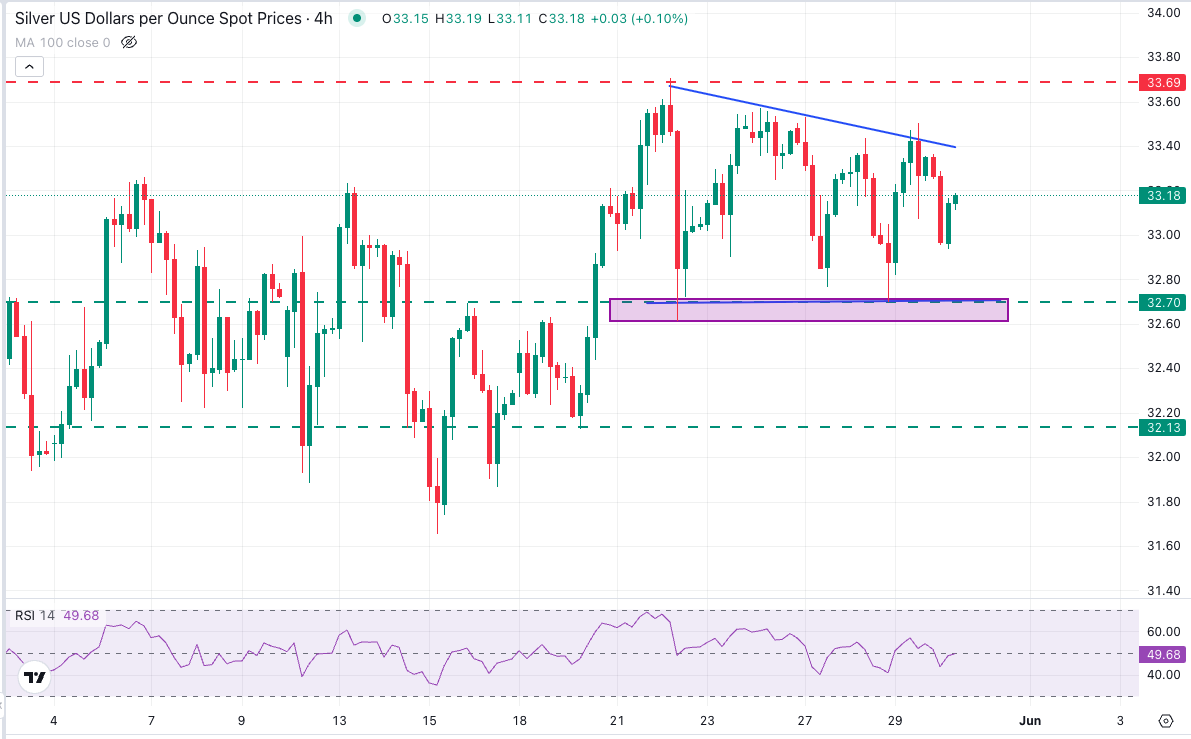Silver Price Forecast: XAG/USD is looking for direction above the $32.70 support area
Silver keeps posting lower highs since peaking at $33.70 last week
Recent price action is forming a descending triangle pattern, a bearish sign.
XAG/USD: Below the $32.60-3270 support, the next targets are $32.15 and $31.70.
Silver prices (XAG/USD) are paring losses during Friday’s European session. The pair has returned above the $33.00 level following a significant reversal during the Asian session.
From a wider perspective, however, price action remains wavering within recent range, with the 4-hour RSI moving back and forth around the 50 level, which indicates a lack of clear momentum.
Technical analysis: XAG/USD remains trading within a triangle pattern
Four-hour charts show the precious metal moving within a descending triangle pattern, printing lower highs since its rejection at $33.70. This pattern often anticipates a bearish outcome.
Immediate support is at the $32.60-32.70 area, where bears were contained in May 22 and 25. If this area gives way, the next support levels are the May 20 low at $32.15 and the May 1 and 15 lows at the $31.70 area.
On the upside, a successful break of the triangle’s top, now around $33.40, cancels this view and brings the $33.70 top back into focus.
XAG/USD 4-Hour Chart

Silver FAQs
Silver is a precious metal highly traded among investors. It has been historically used as a store of value and a medium of exchange. Although less popular than Gold, traders may turn to Silver to diversify their investment portfolio, for its intrinsic value or as a potential hedge during high-inflation periods. Investors can buy physical Silver, in coins or in bars, or trade it through vehicles such as Exchange Traded Funds, which track its price on international markets.
Silver prices can move due to a wide range of factors. Geopolitical instability or fears of a deep recession can make Silver price escalate due to its safe-haven status, although to a lesser extent than Gold's. As a yieldless asset, Silver tends to rise with lower interest rates. Its moves also depend on how the US Dollar (USD) behaves as the asset is priced in dollars (XAG/USD). A strong Dollar tends to keep the price of Silver at bay, whereas a weaker Dollar is likely to propel prices up. Other factors such as investment demand, mining supply – Silver is much more abundant than Gold – and recycling rates can also affect prices.
Silver is widely used in industry, particularly in sectors such as electronics or solar energy, as it has one of the highest electric conductivity of all metals – more than Copper and Gold. A surge in demand can increase prices, while a decline tends to lower them. Dynamics in the US, Chinese and Indian economies can also contribute to price swings: for the US and particularly China, their big industrial sectors use Silver in various processes; in India, consumers’ demand for the precious metal for jewellery also plays a key role in setting prices.
Silver prices tend to follow Gold's moves. When Gold prices rise, Silver typically follows suit, as their status as safe-haven assets is similar. The Gold/Silver ratio, which shows the number of ounces of Silver needed to equal the value of one ounce of Gold, may help to determine the relative valuation between both metals. Some investors may consider a high ratio as an indicator that Silver is undervalued, or Gold is overvalued. On the contrary, a low ratio might suggest that Gold is undervalued relative to Silver.

